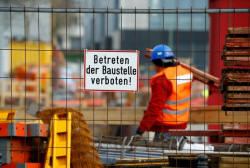|
 Consumers
and construction drive German growth, Brexit clouds
outlook Consumers
and construction drive German growth, Brexit clouds
outlook
 Send a link to a friend
Send a link to a friend
[May 24, 2016]
By Michael Nienaber
BERLIN (Reuters) - Higher consumption and
construction propelled German growth to its strongest quarterly rate in
two years at the start of 2016, data showed on Tuesday, but risks
including weaker trade and a potential British exit from the EU are seen
slowing its pace.
|
|
 The European Central Bank's ultra-low interest rates and the German
government's increased spending on migrants were among factors
singled out by analysts to explain GDP growth of 0.7 percent in
Europe's largest economy in the first quarter. The European Central Bank's ultra-low interest rates and the German
government's increased spending on migrants were among factors
singled out by analysts to explain GDP growth of 0.7 percent in
Europe's largest economy in the first quarter.
"The calculation of consumers is pretty simple: If there are no
interest rates on the bank account, then let's just fill the
shopping bag," VP Bank economist Thomas Gitzel said, adding that
companies also increased investment in the first quarter.
A survey by think tank ZEW showed the mood among analysts and
investors worsened unexpectedly in May, however, with its economic
sentiment index falling to 6.4 points. A separate gauge of current
conditions rose to 53.1 points.
"Uncertainties such as a possible Brexit do not allow a more
optimistic outlook," ZEW president Achim Wambach said, adding
investors had doubts that the economy would continue to grow at the
same pace after the surprisingly strong first quarter.

Britons will vote in June 23 referendum on whether to stay in the EU.
Confirming its preliminary reading, the Statistics Office said
consumer spending and construction investment contributed 0.2
percentage points each to GDP in the January-March period.
State spending -- including the costs of accommodating and
integrating last year's record influx of the more than 1 million
migrants -- and company investment in equipment and plants each
contributed 0.1 percentage points to growth.
A purchasing managers survey showed on Monday that the private
sector accelerated in May to its highest level this year, suggesting
the economy will extend its surprisingly strong start into the
second quarter.
"TURBO START"
Germany's DIHK Chambers of Industry and Commerce raised its 2016
growth forecast for the German economy to 1.5 percent from a
previous estimate of 1.3 percent.
"Construction and consumption will drive this year's economic
upswing," DIHK's managing director, Martin Wansleben, said, adding
that low oil prices, cheap borrowing costs and increased state
spending on migrants were positive factors.
On the downside, he said that Germany was getting little impetus
from foreign demand. "After the turbo start, the economy will grow
at a slower pace in coming months," he said.
[to top of second column] |

BayernLB economist Stefan Kipar said public spending on migrants was
having a broad effect on domestic demand.
"The higher state spending on refugees is lifting private
consumption through payment of social benefits," he said. "And it's
also giving the construction sector an additional push because more
refugee shelters are being built."
The government plans to spend 9.7 billion euros ($10.8 billion) on
supporting and integrating refugees this year, in addition to 6.3
billion euros on combating the causes of migration from the Middle
East and elsewhere.
The total sum of 16 billion euros is expected to rise in coming
years, with Berlin planning to spend 93.6 billion euros overall by
2020 while keeping a balanced budget.
On top of this come several billion euros of spending on migrants by
the federal states and municipalities.
Germany's strong domestic demand more than compensated for sluggish
export growth as an economic slowdown in emerging markets such as
China clouds the outlook.
Net foreign trade was a drag of 0.1 points as exports rose at a
weaker pace than imports in the first quarter, data showed. Due to
this trend, the government and the central bank both expect
Germany's economic upswing to continue at a slower pace.

For 2016 as a whole, Berlin predicts a GDP growth rate of 1.7
percent, on a par with last year.
(Reporting by Michael Nienaber; Additional reporting by Klaus Lauer;
Editing by Madeline Chambers and Robin Pomeroy)
[© 2016 Thomson Reuters. All rights
reserved.] Copyright 2016 Reuters. All rights reserved. This material may not be published,
broadcast, rewritten or redistributed. |